Indexed In
- Open J Gate
- Genamics JournalSeek
- Academic Keys
- JournalTOCs
- ResearchBible
- China National Knowledge Infrastructure (CNKI)
- Scimago
- Ulrich's Periodicals Directory
- Electronic Journals Library
- RefSeek
- Hamdard University
- EBSCO A-Z
- OCLC- WorldCat
- SWB online catalog
- Virtual Library of Biology (vifabio)
- Publons
- MIAR
- Scientific Indexing Services (SIS)
- Euro Pub
- Google Scholar
Useful Links
Share This Page
Journal Flyer

Open Access Journals
- Agri and Aquaculture
- Biochemistry
- Bioinformatics & Systems Biology
- Business & Management
- Chemistry
- Clinical Sciences
- Engineering
- Food & Nutrition
- General Science
- Genetics & Molecular Biology
- Immunology & Microbiology
- Medical Sciences
- Neuroscience & Psychology
- Nursing & Health Care
- Pharmaceutical Sciences
Review Article - (2021) Volume 12, Issue 8
Applications of Nanotechnology for Wireless Sensor Networks
Dr. Sumit Kumar Gupta1* and Rachna Shukla22Research Scholar SRU University Alwar, India
Received: 28-Jul-2021 Published: 19-Aug-2021, DOI: 10.35248/2157-7439.21.12.573
Abstract
This paper reviews the expected wide and profound impact of nanotechnology for future wireless devices and communication technologies. This article points out the possibilities of overcoming the same problem set from a device perspective by taking advantage of the merits of nanotechnologies. At the same time, open research issues and challenges are identified to spark new interests and developments in this field.
Devices that use wireless communication range from RFID tags to TV receivers, and satellites to mobile phones. The availability of internet access from tablets and mobile phones is growing at an exponential rate, causing increasing demands on the performance of wireless networks and mobile devices. Some passive components necessary in wireless devices, such as inductors and capacitors, cannot be minimized as quickly as transistors and integrated circuits. This imbalance makes it likely that the performance requirements of mobile handsets will exceed the capabilities of current RF technologies within the next 10 to 15 years. As well as the global growth in mobile internet access via tablets and smartphones, wireless sensors, health monitoring systems and other devices dependent on wireless communication are becoming more and more prevalent. Developing more compact, more efficient, and less expensive wireless communication devices will have significant impact on these areas and enable new solutions for healthcare services, logistics and environmental monitoring.
The devices that use wireless communication ranges from RFID tags to television set receivers and satellites to mobile phones. The availability of internet access from mobile devices is growing at an exponential rate that causes rising demand on the wireless network and mobile devices' performance. As the type of activities that consumers are engaging in over the wireless connections is changing day in day out, it has been an increased need for the devices to change also. For instance in radios, the increasing quantity of mobile internet traffic there has been increased the need for additional frequency for support. The modern world is becoming an intelligent interactive environment that has needs novel autonomous sensors with wireless communication links that require to be incorporated into an everyday object. This is the reason why sensors that are nanoenabled integrated with small RF transceivers are useful in monitoring air quality, water pollution among other aspects. The main drivers of changing into nanotechnology in wireless devices are needed for high performance, reduced consumption of power as well as reduced compact size.
Keywords
Devices; Bone cement; Wireless; Sensor phenomena and characterization; Wireless communication
Introduction
A Wireless Sensor Network is one kind of wireless network that includes a large number of circulating, self-directed, minute, low powered devices named sensor nodes called motes. These networks certainly cover a huge number of spatially distributed, little, batteryoperated, embedded devices that are networked to caringly collect, process, and transfer data to the operators, and it has controlled the capabilities of computing & processing [1]. Nodes are tiny computers, which work jointly to form networks in (Figure 1).
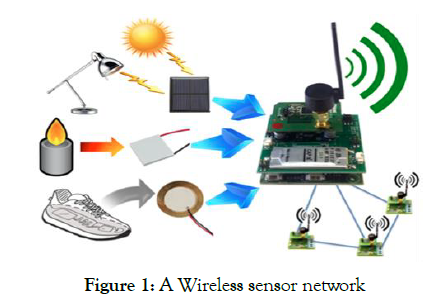
Figure 1: A Wireless sensor network
The sensor node is a multi-functional, energy-efficient wireless device. The applications of motes in industrial are widespread. A collection of sensor nodes collects the data from the surroundings to achieve specific application objectives. The communication between motes can be done with each other using transceivers. In a wireless sensor network, the number of motes can be in the order of hundreds/even thousands. In contrast with sensor n/ws, Ad Hoc networks will have fewer nodes without any structure.
Wireless Sensors
The trend towards intelligent environment and ubiquitous information access means that new types of autonomous sensors with wireless communication links will be embedded in everyday objects. The devices must be small, cheap and capable of operating with power supplied by a very small battery, or electricity harvested from light, radio waves or thermal energy [2]. New nano-enabled sensors combined with miniaturized RF transceivers can be used for health monitoring devices, and monitoring of air quality, soil or water pollution. RFID tags are very simple, usually passive devices, which can be read using a radio frequency trans ceiver. Fabrication by printing can reduce the costs of wireless sensors costs substantially, and nanoparticle inks can be used to increase the performance of the printed devices
Challenges
Key drivers for using nanotechnology in wireless communications come from improved performance, smaller power consumption, smaller size and new features such as flexibility or transparency. Some of these are already proven to be technologically feasible, but many technological difficulties are still unsolved. Cost reduction is an important driver: new technologies will not gain market share until they become cost competitive with existing solutions [3]. The barriers of commercialisation of new technologies for RF electronics are less severe than in digital electronics, since there is a clear need for replacement technologies.
Sensors and Sensing Everywhere
Micromechanical sensors became an elementary part of automotive technologies in mid-1990, roughly ten years later more miniaturized micromechanical sensors are enabling novel features for consumer electronics and mobile devices. Within next ten years the development of truly embedded sensors based on nanostructures will become a part of our everyday intelligent environments. Nanotechnologies may also augment the sensory skills of humans based on wearable or embedded sensors and the capabilities to aggregate this immense global sensory data into meaningful information for our everyday life. This requires novel technologies and cross-disciplinary research in many ways [4,5]. Embedding intelligent and autonomous devices into physical objects of the world requires that devices adapt to their environment and become a part of the network of devices surrounding them. There is no way to configure this kind of a huge system manually–top down. Nanotechnology can help to develop novel kind of intelligent devices where learning is one of the key characteristic properties of the system, similarly to biological systems which grow and adapt to the environment autonomously. Nanotechnologies may open solutions for sensors that are robust in harsh environmental conditions and that are stable over long period of time. Today mechanical sensors – pressure and acceleration sensors – are already demonstrated to fulfil these requirements, but we do not have chemical or biochemical sensors that are stable or robust enough. Furthermore, the future embedded sensors need to be so inexpensive and ecologically sustainable that they can be used in very large numbers. Driver for nanotechnologies in sensors is not primarily miniaturization. The size of the sensor depends on measurement itself,
Wireless sensor networks (wsn) Topologies
There are four common sensor network topologies:
1. Point to point network
2. Star network
3. Tree network
4. Mesh network
We will discuss each of them briefly.
1. Point to Point Netwrok Topology
In this topology, there is no central hub. A node can communicate directly to another node. This is the most common topology and it has a single data communication channel which offers a secure communication path. Each device can act as a client and a server in it (Figure 2).
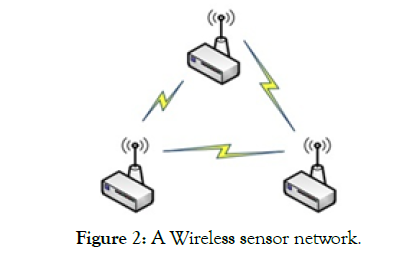
Figure 2: A Wireless sensor network.
2. Star Netwrok Topology
Unlike point to point networks, a centralized communication hub is present in a star network. Each communication is done through this centralized hub and no direct communications between the nodes are possible. In this case, central hub is the server and the nodes are clients (Figure 3).
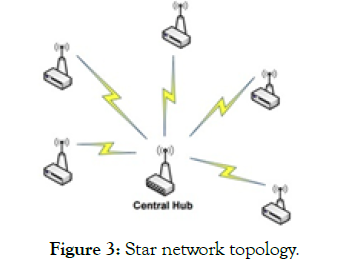
Figure 3: Star network topology.
3. Tree Network Topology
This topology is said to be a hybrid of point to point and star topologies. The central hub in it is called a root node or the parent node. Data is passed on from leaf nodes to the parent node. The main advantage of this topology is less power consumption as compared to other networks (Figure 4).
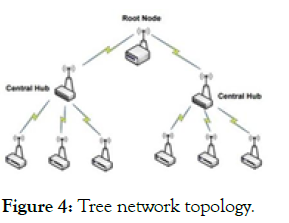
Figure 4: Tree network topology.
4. Mesh Network Topology
In the mesh network, the data can ‘hop’ from one node to another.
All the nodes can communicate with each other directly without having to depend on a central communication hub. This is the most reliable structure of network communication because there is no single point of failure in it. But this structure is very complex and requires a lot of power consumption (Figure 5).
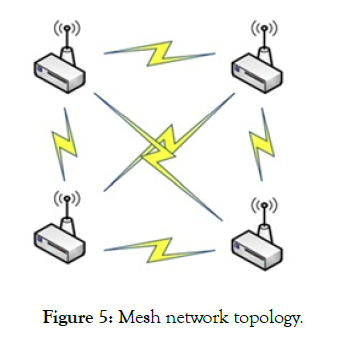
Figure 5: Mesh network topology.
Types of Wireless Sensor Networks
There are different types of sensor networks such as underground, underwater, terrestrial and multimedia WSNs etc. We will discuss them briefly.
1. Terrestrial WSNs
These types of networks consist of hundreds or thousands of wireless sensor nodes. These nodes can be deployed in an unstructured or a structured manner. The nodes are distributed randomly in an unstructured mode, but they are kept within the target area. As these are the ‘terrestrial’ sensor networks therefore they are above ground and solar cells can be used to power up these networks. The energy can be conserved by minimizing delays and by using operations of low duty cycles etc.'
2. Underground WSNs
These sensor networks are more costly as compared to terrestrial networks. The equipment’s used are expensive and proper maintenance is needed. These are effectively used to monitor the underground conditions therefore their whole network is underground but to pass on the information to the base station, sink nodes are used which are present above the ground (Figure 6). Problems are faced while recharging the batteries of the underground sensor networks and loss of signal can also occur due to high level of attenuation in the underground environment.
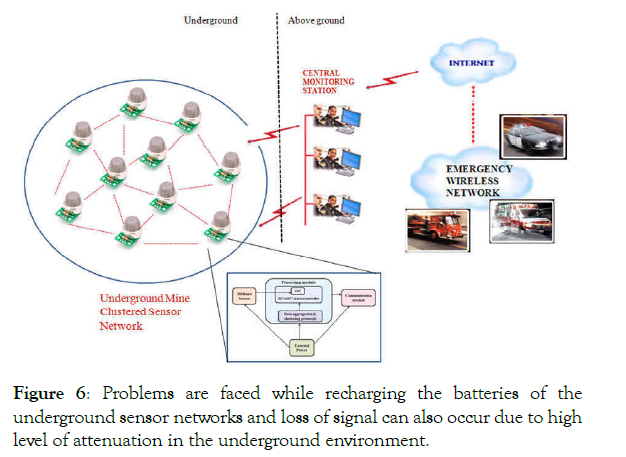
Figure 6:Problems are faced while recharging the batteries of the underground sensor networks and loss of signal can also occur due to high level of attenuation in the underground environment.
3. Underwater WSNs
Underwater wireless sensor network system comprises of sensor nodes and vehicles which are deployed under the water. To gather data from the sensor nodes, underwater vehicles are to be used. The long propagation delay and sensor failures are a big challenge to the underwater communication system. The battery of these WSNs is also limited and cannot be recharged; therefore, different techniques are being developed to solve this issue of energy usage and conservation (Figure 7).
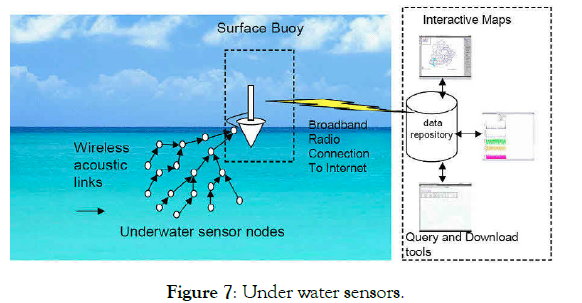
Figure 7: Under water sensors.
4. Multimedia WSNs
These sensor networks can gather information in the form of audio, video and imaging. The sensor nodes in these networks are connected with cameras and microphones. They can track and monitor different events occurring and can keep a visual display of the events also. For the purpose of data compression, retrieval and correlation, these nodes are also interconnected with one another through a wireless connection (Figure 8).
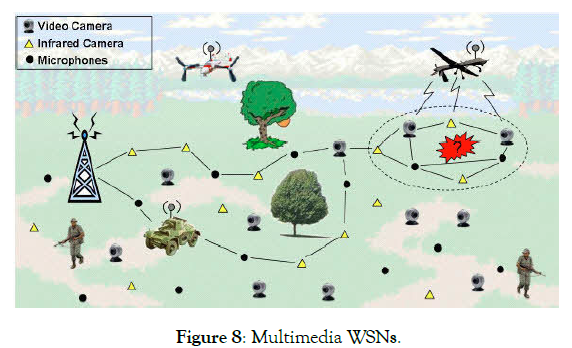
Figure 8: Multimedia WSNs.
As audio and visual data can also be transmitted through these networks therefore they require high consumption of power and high bandwidth. Advanced techniques of data processing and compression are used in it.
5. Mobile WSNs
The mobile network, as the name suggests, is not fixed rather the sensor nodes can move from one place to any other. They can be easily interfaced with the environment around them. Their main advantage is that they provide better coverage, superior channel capacity and enhanced coverage. These mobile WSNs are more versatile as compared to the other static sensor network systems.
Applications of wireless sensor Networks
There are numerous applications of WSNs in industrial automation, traffic monitoring and control, medical device monitoring and in many other areas. Some of applications are discussed below:
1. Disaster Relief Operation
If an area is reported to have been stricken from some sort of calamity such as wildfire, then drop the sensor nodes on the fire from an aircraft. Monitor the data of each node and construct a temperature map to devise proper ways and techniques to overcome the fire (Figure 9).
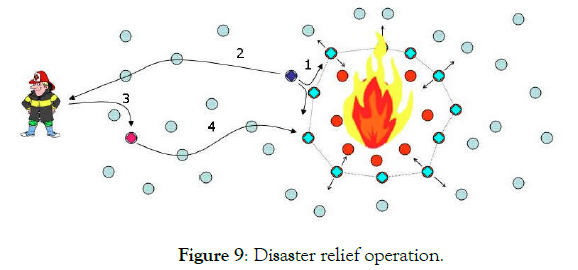
Figure 9: Disaster relief operation.
2. Military Applications
As the WSNs can be deployed rapidly and are self-organized therefore they are very useful in military operations for sensing and monitoring friendly or hostile motions. The battlefield surveillance can be done through the sensor nodes to keep a check on everything in case more equipment, forces or ammunitions are needed in the battlefield. The chemical, nuclear and biological attacks can also be detected through the sensor nodes (Figure 10).
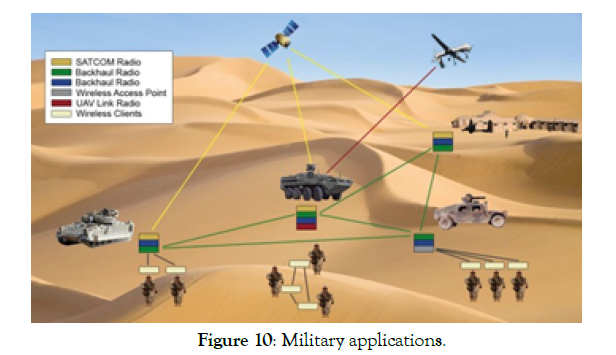
Figure 10: Military applications.
An example of this is the ‘sniper detection system’ which can detect the incoming fire through acoustic sensors and the position of the shooter can also be estimated by processing the detected audio from the microphone.
3. Environmental Applications
These sensor networks have a huge number of applications in the environment. They can be used to track movement of animals, birds and record them. Monitoring of earth, soil, atmosphere context, irrigation and precision agriculture can be done through these sensors. They can also use for the detection of fire, flood, earthquakes, and chemical/biological outbreak etc (Figure 11). A common example is of ‘Zebra Net’. The purpose of this system is to track and monitor the movements and interactions of zebras within themselves and with other species also.
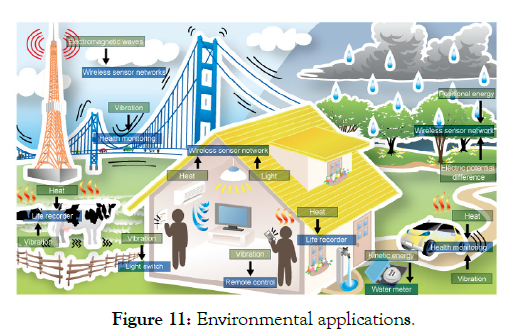
Figure 11: Environmental applications.
4. Medical Applications
In health applications, the integrated monitoring of a patient can be done by using WSNs. The internal processes and movements of animals can be monitored. Diagnostics can be done. They also help in keeping a check on drug administration in hospitals and in monitoring patients as well as doctors.
An example of this is ‘artificial retina’ which helps the patient in detecting the presence of light and the movement of objects. They can also locate objects and count individual items.
5. Home Applications
As the technology is advancing, it is also making its way in our household appliances for their smooth running and satisfactory performance. These sensors can be found in refrigerators, microwave ovens, vacuum cleaners, security systems and also in water monitoring systems. The user can control devices locally as well as remotely with the help of the WSNs (Figure 12).
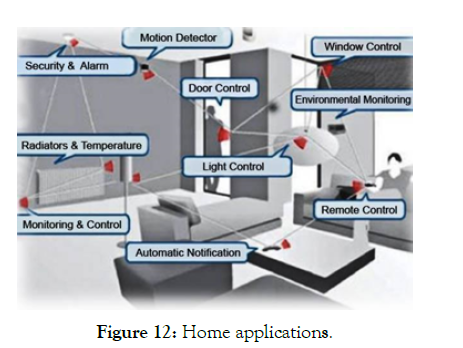
Figure 12: Home applications.
REFERENCES
- Sazonova V, Yaish Y, Ustünel H, Roundy D, Arias TA, McEuen P et al. A tunable carbon nanotube electromechanical oscillator. Nature. October 2004; 43:284-287.
- She JPM, Yeow JTW. Nanotechnology-Enabled Wireless Sensor Networks: Overcoming the Limitations from a Device Perspective in Proceedings of the IEEE International Conference on Mechatronics and Automation. Niagara Falls. Canada, 2005.
- Pendry J, Shurig D, Smith D. Controlling electromagnetic fields. Science. 2019; 312(2):1780-1782.
- International Technology Roadmap for Semiconductors. Emerging Research Devices. 2005 Edition.
- Snider G. S, Williams R. S. Nano/CMOS architectures using a Field-programmable nanowire interconnect. Nanotechnology. 2017;18:1-11.
- Wolf S. A. Spintronics: A Spin-Based Electronics Vision for the Future. Science. 2001; 294:1488–1495.
- Imre A, Csaba G, Ji L, Orlov A, Bernstein G. H, Porod W et al. Majority Logic Gate for Magnetic Quantum-Dot Cellular Automata. Science. 2006; 311:205-208.
- Dalton A, Collins S, Razal J, Munoz E, Von Howard E, Kim B et al. Super-tough carbon-nanotube fibers. Nature. 2011; 423:703.
- Ma M, Hill MR. Super hydrophobic surfaces. Curr Opin Colloid Interface Sci. 2006; 11:193–202.
Citation: Gupta SK, Shukla R (2021) Applications of Nanotechnology for Wireless Sensor Networks. J Nanomed Nanotech. 12: 573.
Copyright: © 2021 Gupta SK, et al. This is an open-access article distributed under the terms of the Creative Commons Attribution License, which permits unrestricted use, distribution, and reproduction in any medium, provided the original author and source are credited.


